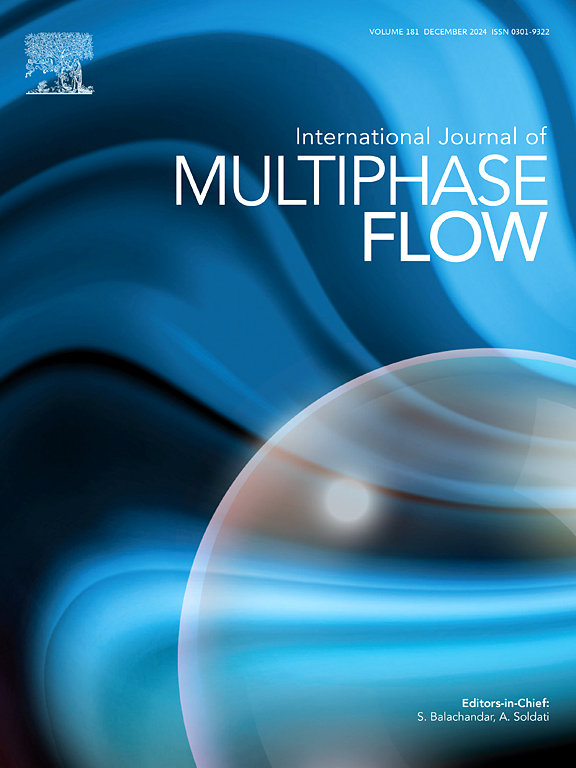Liquid evaporation from nanochannel with rough wall surface by direct simulation Monte Carlo
IF 3.8
2区 工程技术
Q1 MECHANICS
International Journal of Multiphase Flow
Pub Date : 2025-07-02
DOI:10.1016/j.ijmultiphaseflow.2025.105352
引用次数: 0
Abstract
Roughness in nanoscale channels has profound influences on liquid flow and evaporation from the channel which is relevant in many cutting-edge applications. The direct simulation Monte Carlo (DSMC) method was employed to numerically study the effects of roughness shape, size and interval distance on the liquid evaporation rate from a nanochannel. It was found that the inclination angle of roughness elements plays a vital role in determining the liquid evaporation resistance of nanochannel. Under sparse roughness condition, the rectangle roughness with larger inclination angle leads to higher evaporation resistance. Under dense roughness condition, the vapor was inhibited from entering the gap between rectangle roughness and the velocity sink effect was weakened. The evaporation resistance for rectangle roughness declined as the roughness interval continued to reduce, while triangle and semicircle roughness with smaller inclination angle could retain the increase of evaporation resistance. Larger roughness size leads to higher evaporation resistance for the three roughness shapes. A phenomenological model was proposed to correlate the computed evaporation resistance; the model accounted for roughness inclination angle and had different behaviors under sparse and dense roughness conditions. The evaporation resistance was well correlated to the newly defined model with error being around ± 5 %.
采用蒙特卡罗直接模拟方法对粗糙壁纳米通道中液体蒸发进行了研究
纳米通道的粗糙度对液体的流动和蒸发有着深远的影响,这与许多前沿应用有关。采用直接模拟蒙特卡罗(DSMC)方法,数值研究了粗糙度形状、尺寸和间隔距离对纳米通道中液体蒸发速率的影响。研究发现,粗糙度元件的倾角对纳米通道的液体蒸发阻力起着至关重要的作用。在稀疏粗糙度条件下,矩形粗糙度倾角越大,蒸发阻力越大。在致密粗糙度条件下,水蒸气被抑制进入矩形粗糙度间隙,速度汇效应减弱。矩形粗糙度的蒸发阻力随粗糙度间隔的减小而减小,而倾角较小的三角形和半圆形粗糙度可以保持蒸发阻力的增加。粗糙度尺寸越大,三种粗糙度形状的蒸发阻力越大。提出了一种现象模型来关联计算得到的蒸发阻力;该模型考虑了粗糙度倾角,并且在稀疏和密集粗糙度条件下具有不同的行为。蒸发阻力与新模型的相关性较好,误差在±5%左右。
本文章由计算机程序翻译,如有差异,请以英文原文为准。
求助全文
约1分钟内获得全文
求助全文
来源期刊
CiteScore
7.30
自引率
10.50%
发文量
244
审稿时长
4 months
期刊介绍:
The International Journal of Multiphase Flow publishes analytical, numerical and experimental articles of lasting interest. The scope of the journal includes all aspects of mass, momentum and energy exchange phenomena among different phases such as occur in disperse flows, gas–liquid and liquid–liquid flows, flows in porous media, boiling, granular flows and others.
The journal publishes full papers, brief communications and conference announcements.

 求助内容:
求助内容: 应助结果提醒方式:
应助结果提醒方式:


